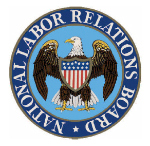Information contained in this publication is intended for informational purposes only and does not constitute legal advice or opinion, nor is it a substitute for the professional judgment of an attorney.
 The National Labor Relations Board created a stir in late 2010 by filing an unfair labor practice charge against ambulance company, AMR, for firing an employee who, among other things, called her supervisor a “mental patient” in a Facebook post read by many co-workers. As it turns out, the “Facebook case” was just the beginning of what appears to be a trend by the Board, subsequently joined by unions, to restrict employers’ ability to promulgate and enforce social media policies that, in the Board’s view, impinge on employees’ rights under the National Labor Relations Act. Several recent developments provide a window into the Board’s intentions.
The National Labor Relations Board created a stir in late 2010 by filing an unfair labor practice charge against ambulance company, AMR, for firing an employee who, among other things, called her supervisor a “mental patient” in a Facebook post read by many co-workers. As it turns out, the “Facebook case” was just the beginning of what appears to be a trend by the Board, subsequently joined by unions, to restrict employers’ ability to promulgate and enforce social media policies that, in the Board’s view, impinge on employees’ rights under the National Labor Relations Act. Several recent developments provide a window into the Board’s intentions.
Last week, the NLRB’s Hartford Regional Director, who was responsible for filing the Facebook case, provided useful information about the Board’s intentions, both in comments and in handout materials, while speaking on a panel for the Connecticut Bar Association. Below are some of the highlights:
- Protected Concerted Activity: In a discipline case, the Board will take a very broad view when deciding whether the employee’s social media activities constituted “protected concerted activity” under the NLRA. The Regional Director’s handout states, “It doesn’t take much to establish the concerted nature of the discussion, so long as it involved or touched upon a term or condition of employment,” and “anything short of physically threatening activity will likely be protected.”
- Recent Cases: The NLRB continues to be active in the area. The handout provides four examples of recently filed complaints, or threatened complaints, involving social media in addition to the case against AMR. These cases show just how broadly the Board construes “protected concerted activity.” They involved, according to the handout, negative comments about a supervisor posted on Facebook, a posted cartoon video about a dispute between two departments, a Facebook discussion about the employer’s withholding of taxes, and a Facebook discussion about the employer’s decision to fill an open position with an outside, rather than an inside, applicant.
- Disclaimers: The Hartford Region will consider a disclaimer when evaluating whether an employer’s social media policy violates the NLRA. According to the Regional Director, the disclaimer should become more specific as the policy becomes broader and more general. For policies that are narrow and easily understood, a disclaimer that the policy is not intended to violate the NLRA may suffice. For broader policies that employees might reasonably believe apply to protected concerted activity, the Region will require a disclaimer which states either that the rule does not apply to “discussions or activities involving your terms and conditions of employment” or that the policy does not apply to “discussions and activities involving your wages, hours and working conditions.” Notably, the Regional Director stopped short of taking the position that to be effective a disclaimer must specifically mention union activity, as another NLRB region recently insisted.
- Litigation Strategy: In the AMR case, the Region subpoenaed online posts of AMR supervisors in an effort to obtain evidence that they made comments about their subordinates similar to the comment that the fired employee had made about her supervisor. In addition, the Region repeatedly told the fired employee to stop posting on Facebook while the litigation was pending (but she ignored the request).
In a development that could resonate beyond social media, the Regional Director also revealed that the Regions, at the direction of the Board’s Acting General Counsel, are filing complaints to set the stage to reverse the Board’s December 2007 decision in Register Guard. In that case, a Republican-dominated Board held that an employer can lawfully impose a broad ban on employee’s use of the corporate e-mail system for solicitations and other non-business reasons as long as the policy on its face does not discriminate against union activity and is enforced in a non-discriminatory manner. A reversal of Register Guard could severely crimp employers’ ability to regulate employees' social media activity while using corporate electronic resources.
In another recent development, the NLRB’s Acting General Counsel added social media to the list of subjects in which he is taking particular interest. While there was virtually no commentary or explanation accompanying this development, it likely reflects that the Board is pursuing a uniform, nationwide strategy on social media.
In a third development in April, the Board threatened to file a complaint against Thomson Reuters for allegedly disciplining an employee based on a Twitter post. The employer had invited employees to post on a corporate-sponsored Twitter feed their thoughts on how the company could be made the best place to work. An employee who also is the Newspaper Guild’s representative tweeted, "One way to make this the best place to work is to deal honestly with Guild members." The Board appears to take issue with the fact that, in response to the post, the employee’s supervisor called to remind her about the company’s policy prohibiting employees from posting content that would damage the company’s reputation. According to a report in the New York Times, an NLRB source stated that the Board viewed this call as potentially having a chilling effect on the employee’s exercise of her rights under the NLRA. On May 2, 2011, it was announced that Thomson Reuters and the Newspaper Guild reached a tentative settlement of their disagreements, heading off an NLRB complaint. If a complaint had been filed, it would have been the first NLRB action based on a Twitter post.
What should employers do?
There can be no question that the Board appears to want to take the law in a direction that will open social media to virtually unfettered use by employees to communicate about work conditions, defined very broadly. However, employers should also recognize that social media buzz (including blogs like this one), press releases, and unproven allegations may be prematurely persuading employers to loosen social media polices that were drafted before the AMR case. As far as we are aware, there has not been a single fact-finding hearing to date in a case where an employee was disciplined for social media conduct, let alone a published decision by even an administrative law judge. The actual limits on an employer’s ability to regulate the use of social media by its employees are still to be developed and refined by the NLRB and by the federal appeals courts that will review its decisions.
Given this uncertainty, employers should continue to watch developments in the area closely, consult counsel before imposing discipline based on social media activity, and review their social media policies. If the policy contains any provision that could be read to limit employees’ ability to communicate about the terms or conditions of employment while using the employee’s own resources during non-working hours, strongly consider adding a disclaimer to the policy. The content of the disclaimer should vary depending upon the nature of the policy. A starting point would be a disclaimer to the effect that the policy will not be applied in a manner that improperly interferes with employees’ rights under the National Labor Relations Act. A more robust disclaimer might be advisable depending upon the breadth of the policy, whether the employer already is unionized, and the degree to which the employer, or the employer’s industry, has been the focus of organizing activity.


